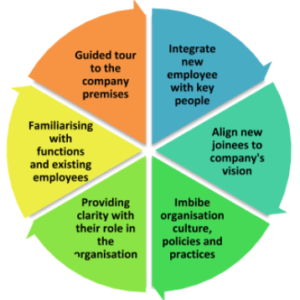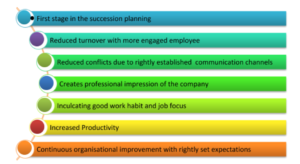Good induction programmes can increase productivity and reduce turnover of staff. These programs can also play a critical role under the socialization to the organization in terms of performance, attitudes and organizational commitment.
As an employer, your staff is your most important asset.
Induction is an essential part of on boarding this asset and familiarising them with your organisation. Getting the induction process right can help you get new employees up to speed and productive as quickly as possible.
The main purpose of induction training is to integrate new employees into the company and make them understand the systems and procedures followed by the organization.
Objectives of Employee Induction

Why Induction for New Joinees?
Induction is an effective way to ensure that the new joinee is able to adjust and acclimatise to organisation’s values, culture , procedures and working environment.
That’s not the only reason, inducting an employee with a well-planned training is a legal requirement under Health & Safety legislations.
What Induction covers on a broader level?
Organisation has to plan induction well in advance to ensure it benefit fully to the organisation.
Induction Essentials:
Before an employee joins planning in terms of resources required for him to perform his duties should be kept ready, calendar of delivery should be prepared, sequence of induction based of availability staff responsible for each activity. Plan should be circulated to everyone in advance including new starter and many more. The list is long for all that is needed to make the induction successful and it has to be known very well.
Though induction is considered as a process when a new staff member joins the organisation, it is not restricted to new hires.
Internal appointments, transfers or promotions may need to be inducted in order to get accustomed to changed expectations and working environment.
Keeping in mind induction for a new hire, below are the major steps involved in basic induction.

Through Induction organisations are able to maintain and improve their standards of care & support.
Types of Induction
Induction can be only formal induction or “Formal plus Informal Induction”. It varies from as short as one day to as long as 30 days including functional training.
Typically Induction is divided into two categories specifically:
- Formal
- Off – the – job
- On – the – job
- Informal
- Inducting through fun activities
- Away from the company premises
Benefits of Induction

In today’s scenario, we need not stick to any one of the ways of Induction. We have to create “The Hybrid Induction Programme”.
How do I make Induction most successful, rewarding and get best ROI (Return On Investment)?
First Impression is the Last Impression, very rightly said and hence it is essential to give the
best and right experience to every new person joining the organisation.
In order to design the “The Hybrid Induction Programme (HIP)” you can use services provided by Aver Consulting & Outsourcing Pvt. Ltd.
We design, develop, deliver customised induction programmes. These consists of
- Classroom Trainings
- Engagement Activities
- Team Building through connect to organisational values
With which organisation achieves
- Clarity in organisational expectations from the employee
- Increased trust and integrity among employees
- More engaged and long term employee
- Better communication
If “Attrition “, “Employee Engagement” are words bothering you the most then you must connect us on isha@aver.co.in or call 9545547548

